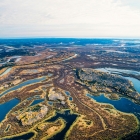The Woods Institute is now part of the Stanford Doerr School of Sustainability
Scenarios for Survival of a UNESCO World Heritage Site
Combining the Distribution of Semi-Aquatic Mammal Populations with Ecohydrologic Analysis
Funding Year:
2016
Region(s):
North America
Research Areas:
Natural Capital
Climate change and human activities such as hydropower development have created ecological impacts and habitat loss at the Peace-Athabasca Delta in northeastern Alberta, Canada, a UNESCO World Heritage Site. Exploring the effects of climate change and human activity on one of the planets largest inland deltas is critical to understanding, mitigating, and adapting to ecohydrologic changes and preserving biodiversity in this and other parts of the world. This project will combine hydrologic modeling and population dynamics of the muskrat, a semi-aquatic rodent whose abundance is indicative of habitat health, to investigate the impacts of these stressors on the ecosystem. Researchers will also account for impacts by and upon aboriginal peoples subsistence and commercial trapping due to changes in muskrat demography.
Principal Investigators:
Steve Gorelick Cyrus Fisher Tolman Professor in the School of Earth Sciences and Senior Fellow at the Woods Institute for the Environment
Elizabeth Hadly Paul S. and Billie Achilles Professor in Environmental Biology, Senior Fellow at the Woods Institute for the Environment and Professor, by courtesy, of Geological Sciences




